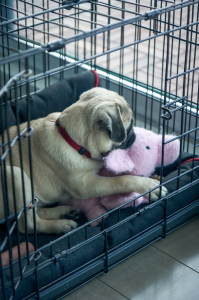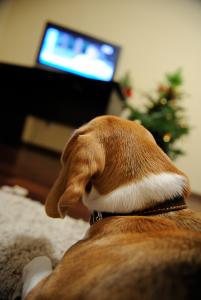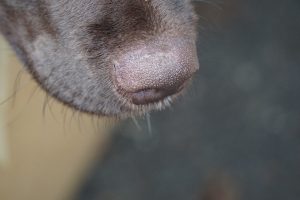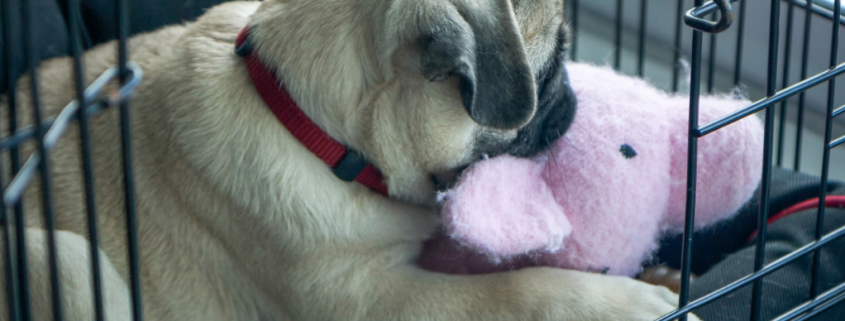Ask Crystal: Staying Sane While Recuperating
Welcome to “Ask Crystal,” where you can ask your pet behavior questions! You can submit your question for Crystal at the bottom of the page!

Dear Crystal,
I’ve got a 10-month-old Cocker spaniel who unfortunately is going through knee surgery/rehabilitation on both his rear legs. Due to this he is crate bound all day except his short lead walks, food and to go to the toilet. He has a variety of toys like Kong etc. My question is what should we do to stop him from digging at the door and/or barking for attention.
Sincerely,
Crate Rest
Dear Crate,
Oh boy, I am really sorry to hear that! That is a tough situation for any dog much less a puppy. Injuries are one of the reasons why I suggest that all dogs be crated trained. At some point, most dogs are going to need to be in crate for a certain period of time and we don’t want the first time the dog is in a crate to be when he is already stressed out and potentially in pain.
If you have time before the surgery, I would recommend working on his crate training as much as possible before then. If he normally scratches at the door and barks when he is in the crate, I would guess that he is not fully crate trained. A dog that has been crate trained should not be that stressed out at being in the crate. My suggestion would be to start completely over with the training. It can take some time to really get a dog comfortable being in the crate. He should be completely comfortable at each step before moving on to the next. There are some dogs that suffer from separation anxiety or crate anxiety and they cannot be crated no matter how much training the owners provide. If that is the case for your dog, you need to speak to your vet prior to surgery. His recovery is unlikely to be successful if he can’t be safely crated.
Beyond him being comfortable in the crate, the most important thing is to keep him calm. We can help dogs to stay calm by first providing a quiet calm environment without a lot of visitors or noises that typically excite the dog as much as possible. Another very important part of keeping a dog calm is tiring them out. There are a lot of ways to tire a dog out without physical exercise so make a plan for how you will provide daily enrichment and training.
Consider having multiple crates so that the dog can have a variety of environments for a change of scenery. You can also move a crate around with you in various rooms in the house. Just because he has to be crated doesn’t mean he should have to be alone all the time. It will possibly help him have a better association with the crate if he isn’t alone in it all the time.
You should have a quiet crate area as well for times of sleep and relaxing. Put a crate in a quiet spot away from the household noises. You may want to cover half the crate and leave the other uncovered so that he has a choice of being covered or not. You may want to use an Adaptil plug in diffuser to help calm your pup with appeasing pheromones. Play some soothing classical music or audio books to sooth your pup and block outside noises. Lavender in a diffuser is a relaxing scent for dogs.
When a dog is on restricted activity, the best thing that we can do for them is provide a lot more mental stimulation. Mental stimulation comes through environmental enrichment and training exercises. If you have ever taken a dog to training class, you know that there are generally pretty tired after class. It’s the same as a person having to really use their brain a lot for taking a test, for example.
Enrichment are things that we add to the dog’s environment or life that allow for more species-specific behavior or activities that provide mental stimulation and allow the animal to make choices. There are a variety of activities and a lot of Facebook groups devoted to sharing ideas amongst animal lovers. All dogs can benefit from the addition of enrichment to their lives.
Rotate toys each day and you can hang or attach some toys to the bars to make it move around as he tries to grab it. The Groov crate training device connects to the bars and gives your pup a popsicle to lick. If your dog likes ice, you can also freeze a clip and slip lead in the water and then clip it on the cage bars for your dog to enjoy.
 Visual stimulation can be provided in a variety of ways. Some dogs enjoy watching other animals on television. You can blow bubbles or put up a wind sock on a slow-moving fan. If you have a small dog, they may be able to ride in a doggie stroller so they can still get new stimuli in a safe way. If your dog enjoys car rides, consider taking them for a car ride in a crate to look at the sights. Always consider what excites your dog when providing enrichment and don’t do activities which will get him too stimulated.
Visual stimulation can be provided in a variety of ways. Some dogs enjoy watching other animals on television. You can blow bubbles or put up a wind sock on a slow-moving fan. If you have a small dog, they may be able to ride in a doggie stroller so they can still get new stimuli in a safe way. If your dog enjoys car rides, consider taking them for a car ride in a crate to look at the sights. Always consider what excites your dog when providing enrichment and don’t do activities which will get him too stimulated.
Food enrichment will be the easiest enrichment to provide, especially for a dog on restricted activity. Stop feeding your dog from a bowl and find ways to make him work for it. Try some of the toys that you can freeze so that it takes a lot longer to get the food out. Examples of this type of toy would be Kongs, Squirrel Dudes and Everlasting Treat Balls to name a few. There are a variety of puzzle toys like those by Nina Ottosson which aren’t meant to be moved around. A snuffle mat can be made inexpensively from household materials for a fun enrichment feeder. You can also make your own from cardboard boxes and paper towel rolls if your dog likes to rip things up.
You will need to sit on the ground for the activities. Your dog should be wearing a leash and harness so that you have control of him. It’s a good idea to teach your dog to sit and wait when you open the crate door so that you can attach his leash without him bolting out of the crate. Keep your movements slow and deliberate and talk in a calm, quiet voice to avoid overexciting him.
Scent work could be a potentially low movement activity. There are a lot of different games to play that use the dog’s nose. It doesn’t have to be anything formal. You can put food in one hand and present your fists to the dog. If they choose the hand with food, open the hand and feed it to them. Otherwise, put your hands behind your back and represent to dog. You can do a shell game with a similar concept of the dog needing to identify the cup with the treat under it. You can use an old muffin tin and tennis balls to hide treats under for your dog to find.
Another game is to poke some holes in the lid of a plastic food container and put some treats in it. Hide the tub in a box and bring a few other boxes in the dog’s room as well. Let him smell each box and when she identifies the box with the treats, she can have them! Repeat a few times a session and play a few times a day.
 You can use scents to place in the crate with the dog. Take rags with you on your daily walk and rub each one on different surfaces that dogs frequently like to sniff and bring back and tie on the bars of the kennel. We like to use scent tubes which are paper towel rolls with treats inside and we drip a little bit of prey scent which you can buy online from hunting websites.
You can use scents to place in the crate with the dog. Take rags with you on your daily walk and rub each one on different surfaces that dogs frequently like to sniff and bring back and tie on the bars of the kennel. We like to use scent tubes which are paper towel rolls with treats inside and we drip a little bit of prey scent which you can buy online from hunting websites.
There are a lot of training exercises you can do with a dog on restricted movement. Training is not only a great way to provide mental stimulation but it makes life a whole lot easier. You can work on handling, stationary exercises or teach your dog fun tricks.
Teaching husbandry related behaviors make life a lot easier and less stressful for you and your dog. Paw handling desensitization and counter conditioning is a great place to start for nail trim work. Teaching your dog a chin rest is the first start to cooperative care and easy to teach. Teach your dog to trim his own nails on a scratching board if he hates nail trims. If your dog is a nervous nelly at the vet, teach him to feel comfortable wearing a muzzle. If your dog doesn’t enjoy being brushed that is another husbandry related behavior you could work on.
One of my favorite things to work on with my dogs are relaxation protocols. These training protocols work by teaching your dog to stay through a variety of increasingly distracting stimuli. It also works to help dogs find relaxation while a variety of things are happening around them and to defer to the human. There are two that I like to use; Dr. Karen Overall’s Relaxation Protocol and Suzanne Clothier’s Really Real Relaxation Protocol.
A really fun way to train your dog is using a clicker to shape behaviors into cute tricks. A lot of tricks can be trained by capturing behaviors that your dog does naturally like sneezing, moving their ears and yawning. You can put most of these behaviors on cue using capturing. Teach your dog to target using their nose or paw. Target is a useful cue for redirecting a distracted dog and it can be used to train a variety of other behaviors; touching a bell to go outside, turning light switches on/off, waving, high fives, touching buttons, really your creativity is the limit! Teach your dog item discrimination and impress your friends by telling your dog which toy to grab.
Don’t discount the importance of physical contact for those dogs that enjoy being touched. Spend some time with your puppy giving him calm physical touch. A gentle massage could help to relax him. Pet slowly keeping your hands on him in smooth, slow strokes. You can also give your pup a gentle brushing if he enjoys that.
If you use some creativity, there are a lot of activities that you can do with a pup on restricted movement. It is a lot to expect a young active dog to be ok with staying in a crate all day with no activities. Even the best crate trained dog is going to get bored of that really quickly so enrichment and training is going to be your best friend for these next couple of months. Good luck and best wishes for a full recovery for your pup!
Until next time,
Crystal







